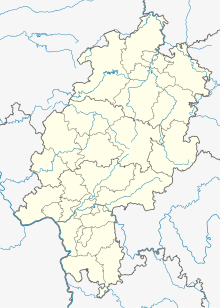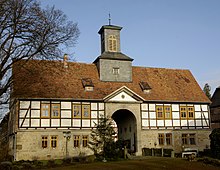Bodenhausen (Ehlen)
Coordinates: 51 ° 20 ′ 15 ″ N , 9 ° 18 ′ 11 ″ E
Bodenhausen , a former manor , is a group of farmsteads in the district of Ehlen , a district of the municipality of Habichtswald in the northern Hessian district of Kassel .
geography
Bodenhausen is located in the Habichtswald Nature Park , 1.5 km northwest of Ehlen. It is located in the Zierenberger Grund (natural area 342.11), the northern part of the Habichtswälder Depression (natural area 342.1), at about 310 m above sea level. NHN in the valley of warmth , which flows past about 200 m to the east on its way north.
In the immediate vicinity of the estate lies the Habichtstein and Warmetal nature reserve near Ehlen ( CDDA no. 163465; designated in 1989; 38 hectares in size), which is divided into two parts on the eastern Habichtstein (also called Habichtstein ; approx. 345 m ) and one Spreading pond in the west of the estate.
The state road 3220 from Ehlen to Zierenberg leads from its junction with the L 3390, which is about 250 m further south, in a curve immediately south and east around the courtyard. The estate is on the student path that connects the four university towns of Göttingen , Kassel , Marburg and Gießen , as well as on the Märchenlandweg and the Warmetal cycle path .
history
The first written mention of the place can be found in a document issued between 1084 and 1088, in which Archbishop Wezilo of Mainz confirmed the donation of the "Botinhusun" farm to the Hasungen monastery located about 2.5 km southwest . The place is later mentioned as "Budinhusen" (1100) and "Bodenhosen" (1234) and as "villa" (1239) and "free yard" (1355).
Until its dissolution in 1527, the monastery owned shares in Gut Bodenhausen. Then the estate fell to Landgrave Philip I , who initially had it managed by a manager before giving it to his chamber master Christoph Scherer in 1539 . From 1662 it belonged to the Privy Council and Rent Chamber President Nikolaus Sixtinus the Elder. J. (1585-1669). With his daughter Catharina (1617–1698) it came to her husband, the Privy Councilor Johannes Goeddaeus (1601–1657). and then to their son Nikolaus Wilhelm Goddaeus (1646–1719), from 1695 until his death Chancellor of the Landgrave of Hessen-Kassel . His daughter from third marriage, Maria Amalia Goeddaeus (1710–1784), inherited Bodenhausen, and through her marriage to the Hessen-Kassel Vice Chancellor Christian Heinrich Motz (1687–1751) the estate came into the possession of the Motz family . About the son of the two, the Hessian Privy Councilor and Rent Chamber President Friedrich Ludwig von Motz (1732–1817), who was raised to imperial nobility in 1780 , and his son, the Hessian Finance, Justice and Foreign Minister Gerhard Heinrich von Motz (1776–1868), Bodenhausen came to the latter's daughter, Helene (1825–1912). She brought the estate through her marriage in 1848 with the Royal Norwegian Chamberlain and Minister-Resident Karl Friedrich Adalbert von und zu Mansbach (1820–1890) to von und zu Mansbach . Today it is still owned by the descendants, currently from Barbara Weidel (née von Mansbach) and her husband. It is used for pony and cattle breeding, primarily with pasture operations.
Former accessories
Good to Bodenhausen at the edge of today's nature reserve Habichtstein two were located mills and the Vorwerk Kalenberg.
The Habichtsteiner Mühle , first mentioned in 1433, about 250 m east of the estate at the foot of the Habichtstein, was demolished in 1977 after a fire. In this mill, which had to pay considerable annual taxes to Hasungen monastery, the farmers from Ehlen and Dörnberg had their grain ground and crushed . A mill ditch derived from the heat drove the overshot mill wheel with a diameter of almost 6 m.
The Bodenhäuser oil mill, about 800 m east-northeast of the estate, had existed since about 1650. It was driven by the extended mill ditch of the Habichtsteiner Mühle and produced oil from linseed and poppy seeds . Milling ceased at the end of the 19th century and the mill was converted into a farm. The house standing there today dates from 1813.
The Vorwerk Kalenberg , first mentioned in 1747 , the exact location of which is not known, also belonged to Gut Bodenhausen. It was abandoned around 1800 and its corridor was merged with that of the Bodenhausen estate.
The attachment
After the end of the Thirty Years War (1618–1648), in which the complex was partially destroyed, it was rebuilt in a representative manner. Today it consists of a southern and a northern part, separated by a barn and stable building, with the (older) northern part being the living area and the southern part being the business part. The southern part is completely surrounded on its south, east and north sides by stables and other farm buildings that follow the curve of the L 3220 in the south-east. The inner courtyard is mostly taken up by two dressage arenas . In the southwest, immediately to the right (east) of today's courtyard entrance, is the so-called tenant house built in the classical style , which closes the courtyard on this side. To the left (west) of the courtyard access is the neat little former blacksmith's shop , now a residential building.
The northern part, the original core of the manor, used to be surrounded by a moat that is no longer preserved. Today only three ponds of different sizes to the west and south of the courtyard remind of this. The access to the courtyard was originally via a bridge over the moat and through a gatehouse. The stately, elongated archway house of about 22 x 8 m in its present form dates from 1649. Above a massive ground floor made of sandstone blocks and a beautiful half-timbered upper floor with light gray beams that was renewed in 1834 , it carries a square, centered on the ridge of the gable roof. Slate-lined and roofed roof turrets with weather vane . The two-storey former round arch leads through the middle of the building , above which a low dwarf house with a flat pointed gable rises. On both sides of the archway there are two double windows with red and white painted shutters on both floors . Both halves of the house have now been converted into apartments.
On the north side of the property, only partially visible from the street, is the three-storey mansion from 1660 with its red half-timbered beams. The building was expanded in the 19th century. At both ends, the gable-sided hipped roof was complemented or replaced by not quite ridge-high, continuous from the front to the back with slotted gables, which gives the impression of two side wings attached at right angles.
In the middle of the park-like courtyard, shielded in the east by large trees from the L 3220, between the manor house and the farm buildings, there is a sandstone fountain. Behind the mansion, a tree-lined park extends north.
Gut Bodenhausen is privately owned and not accessible to the public, but from the L 3220 you can look into the homestead, which is well worth seeing, and especially see the stately gatehouse. In the manor park there is an oak tree with a chest height of 7.05 m (2016).
Footnotes
- ↑ Map services of the Federal Agency for Nature Conservation ( information )
- ^ ADB: Sixtinus, Nicolaus , on wikisource
- ^ "Goeddaeus, Johannes" ,. Hessian biography. In: Landesgeschichtliches Informationssystem Hessen (LAGIS).
- ↑ Maria Amalia Goeddaeus also brought the Oberurff estate in the Schwalm-Eder district , which she had inherited from her brother Carl Reinhard Goeddaeus, into her marriage.
- ^ Karl Friedrich Adalbert [from and to Mansbach] . In: Marcelli Janecki , Deutsche Adelsgenossenschaft (Hrsg.): Yearbook of the German nobility . Second volume. WT Bruer's Verlag, Berlin 1898, p. 549 ( dlib.rsl.ru ).
- ↑ Bodenhäuser Mühlen , according to Eco path cultural history Habichtswald on eco-pfade.de (PDF; 131 kB)
- ↑ "Kalenberg, District of Kassel". Historical local dictionary for Hessen. (As of July 29, 2015). In: Landesgeschichtliches Informationssystem Hessen (LAGIS).
- ↑ Oak at Gut Bodenhausen in the directory of monumental oaks . Retrieved January 1, 2017
literature
- Christina Vogt: Gut Bodenhausen. In: mansions. Palaces, castles, manors. M. Faste Publishing House, Kassel 2003.
- Wilhelm A. Eckhardt: The Hasunger Klosterhof Bodenhausen. In: Hess. Yearbook for national history. 1993, pp. 237-248.
Web links
- "Gut Bodenhausen, District of Kassel". Historical local dictionary for Hessen. In: Landesgeschichtliches Informationssystem Hessen (LAGIS).
- Photo of the archway house , on habichtswald.de
- Gut Bodenhausen , on eco-pfade.de



